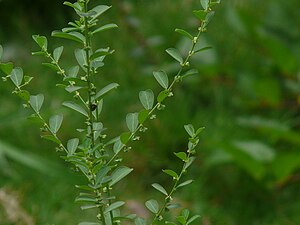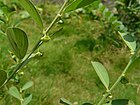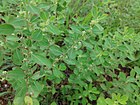Note: This is a project under development. The articles on this wiki are just being initiated and broadly incomplete. You can Help creating new pages.
Difference between revisions of "Phyllanthus maderaspatensis"
| Line 1: | Line 1: | ||
| − | + | [[File:Hajar-mani (Hindi- हजारमणी) (2909033367).jpg|thumb|right]] | |
| + | '''Phyllanthus maderaspatensis''' is an erect to spreading, unbranched to much-branched, annual to perennial plant with stems that can become more or less woody and persist for more than a year. It can grow up to 90cm tall, occasionally to 120cm. The plants are harvested from the wild for local use as a medicine. They are traded locally in market places and are also sold for the commercial production of pharmaceutical products. | ||
==Uses== | ==Uses== | ||
| − | {{Uses|}}, {{Uses|}}, {{Uses|}}, {{Uses|}}, {{Uses|}}, {{Uses|}}, {{Uses| | + | {{Uses|Toothache}}, {{Uses|Rheumatism}}, {{Uses|Headache}}, {{Uses|Bronchitis}}, {{Uses|Earache}}, {{Uses|Ophthalmia}}, {{Uses|Jaundice}}. |
==Parts Used== | ==Parts Used== | ||
| Line 7: | Line 8: | ||
==Chemical Composition== | ==Chemical Composition== | ||
| − | <ref name="chemical composition"/> | + | It contains n-tetracosane, taraxeryl acetate, ester of β-sitosterol, taraxerol, hexacosane, 32-methyltritriacontanol-1, heptacosanol-14, 11-hydroxyhexacosan-3- one, tetracos-20(cn)-1,18-diol, β-sitosterol and oleana-11,13(18)dienc- 3β,24-diol etc.<ref name="chemical composition"/> |
==Common names== | ==Common names== | ||
| − | {{Common names|sa=|en=|gu=|hi=|kn=|ks=|ml=|mr=|pa=|ta=|te=}} | + | {{Common names|sa=Bhumyaamalaki|en=Madras Leaf-Flower|gu=|hi=Hajarmani, Kanocha|kn=ಮದರಾಸ್ ನೆಲ್ಲಿ Madaraas nelli|ks=|ml=|mr=Bhuiavali|pa=|ta=Nila-nelli|te=Nalla usirika}} |
==Properties== | ==Properties== | ||
| Line 16: | Line 17: | ||
===Dravya=== | ===Dravya=== | ||
===Rasa=== | ===Rasa=== | ||
| − | |||
===Guna=== | ===Guna=== | ||
| Line 29: | Line 29: | ||
==Habit== | ==Habit== | ||
| − | {{Habit|}} | + | {{Habit|Perennial}} |
==Identification== | ==Identification== | ||
| Line 48: | Line 48: | ||
==Mode of Propagation== | ==Mode of Propagation== | ||
| − | {{Propagation|}} | + | {{Propagation|Seeds}} |
==How to plant/cultivate== | ==How to plant/cultivate== | ||
| − | <ref name="How to plant/cultivate"/> | + | It grows on a wide variety of soils, usually on heavy clay and alluvial soils of low-altitude river valleys, on river banks and in flood plains.<ref name="How to plant/cultivate"/> |
==Commonly seen growing in areas== | ==Commonly seen growing in areas== | ||
| − | {{Commonly seen|}}, {{Commonly seen|}}, {{Commonly seen|}}, {{Commonly seen| | + | {{Commonly seen|Deciduous woodland}}, {{Commonly seen|Wooded savannah}}, {{Commonly seen|Grassland}}, {{Commonly seen|On beaches}}. |
==Photo Gallery== | ==Photo Gallery== | ||
<gallery class="left" caption="" widths="140px" heights="140px"> | <gallery class="left" caption="" widths="140px" heights="140px"> | ||
| − | + | Hajar-mani (Hindi- हजारमणी) (2909033367).jpg | |
| + | Kachora (Marathi- कचोरा) (2909034961).jpg | ||
| + | மேலாநெல்லி5.jpg | ||
</gallery> | </gallery> | ||
| Line 64: | Line 66: | ||
<references> | <references> | ||
| − | <ref name="chemical composition">[ | + | <ref name="chemical composition">[https://www.researchgate.net/publication/279699592_Chemical_constituents_of_Phyllanthus_maderaspatensis_Linn Chemical constituents]</ref> |
| − | <ref name="Leaf">[ | + | <ref name="Leaf">[Morphology]</ref> |
| − | <ref name="How to plant/cultivate">[ | + | <ref name="How to plant/cultivate">[http://tropical.theferns.info/viewtropical.php?id=Phyllanthus+maderaspatensis Cultivation]</ref> |
<ref name="Uses">Indian Medicinal Plants by C.P.Khare</ref> | <ref name="Uses">Indian Medicinal Plants by C.P.Khare</ref> | ||
</references> | </references> | ||
==External Links== | ==External Links== | ||
| − | * [ ] | + | * [http://www.flowersofindia.net/catalog/slides/Madras%20Leaf-Flower.html Phyllanthus maderaspatensis on flowersofindia.net] |
| − | * [ ] | + | * [https://indiabiodiversity.org/species/show/230704 Phyllanthus maderaspatensis on indiabiodiversity.org] |
| − | * [ ] | + | * [https://www.prota4u.org/database/protav8.asp?g=pe&p=Phyllanthus+maderaspatensis+L. Phyllanthus maderaspatensis on prota4u.org] |
[[Category:Herbs]] | [[Category:Herbs]] | ||
[[Category:Pages without herbs images]] | [[Category:Pages without herbs images]] | ||
Revision as of 16:40, 1 July 2020
Phyllanthus maderaspatensis is an erect to spreading, unbranched to much-branched, annual to perennial plant with stems that can become more or less woody and persist for more than a year. It can grow up to 90cm tall, occasionally to 120cm. The plants are harvested from the wild for local use as a medicine. They are traded locally in market places and are also sold for the commercial production of pharmaceutical products.
Contents
- 1 Uses
- 2 Parts Used
- 3 Chemical Composition
- 4 Common names
- 5 Properties
- 6 Habit
- 7 Identification
- 8 List of Ayurvedic medicine in which the herb is used
- 9 Where to get the saplings
- 10 Mode of Propagation
- 11 How to plant/cultivate
- 12 Commonly seen growing in areas
- 13 Photo Gallery
- 14 References
- 15 External Links
Uses
Toothache, Rheumatism, Headache, Bronchitis, Earache, Ophthalmia, Jaundice.
Parts Used
[[:Category:Herbs with used in medicine|]], stem, leaves, Root.
Chemical Composition
It contains n-tetracosane, taraxeryl acetate, ester of β-sitosterol, taraxerol, hexacosane, 32-methyltritriacontanol-1, heptacosanol-14, 11-hydroxyhexacosan-3- one, tetracos-20(cn)-1,18-diol, β-sitosterol and oleana-11,13(18)dienc- 3β,24-diol etc.[1]
Common names
| Language | Common name |
|---|---|
| Kannada | ಮದರಾಸ್ ನೆಲ್ಲಿ Madaraas nelli |
| Hindi | Hajarmani, Kanocha |
| Malayalam | |
| Tamil | Nila-nelli |
| Telugu | Nalla usirika |
| Marathi | Bhuiavali |
| Gujarathi | |
| Punjabi | |
| Kashmiri | |
| Sanskrit | Bhumyaamalaki |
| English | Madras Leaf-Flower |
Properties
Reference: Dravya - Substance, Rasa - Taste, Guna - Qualities, Veerya - Potency, Vipaka - Post-digesion effect, Karma - Pharmacological activity, Prabhava - Therepeutics.
Dravya
Rasa
Guna
Veerya
Vipaka
Karma
Prabhava
Habit
Identification
Leaf
| Kind | Shape | Feature |
|---|---|---|
Flower
| Type | Size | Color and composition | Stamen | More information |
|---|---|---|---|---|
| {{{5}}} |
Fruit
| Type | Size | Mass | Appearance | Seeds | More information |
|---|---|---|---|---|---|
Other features
List of Ayurvedic medicine in which the herb is used
Where to get the saplings
Mode of Propagation
How to plant/cultivate
It grows on a wide variety of soils, usually on heavy clay and alluvial soils of low-altitude river valleys, on river banks and in flood plains.[3]
Commonly seen growing in areas
Deciduous woodland, Wooded savannah, Grassland, On beaches.
Photo Gallery
References
- ↑ Chemical constituents
- ↑ [Morphology]
- ↑ Cultivation
Cite error: <ref> tag with name "Uses" defined in <references> is not used in prior text.
External Links
- Pages with reference errors
- Ayurvedic Herbs known to be helpful to treat Toothache
- Ayurvedic Herbs known to be helpful to treat Rheumatism
- Ayurvedic Herbs known to be helpful to treat Headache
- Ayurvedic Herbs known to be helpful to treat Bronchitis
- Ayurvedic Herbs known to be helpful to treat Earache
- Ayurvedic Herbs known to be helpful to treat Ophthalmia
- Ayurvedic Herbs known to be helpful to treat Jaundice
- Herbs with used in medicine
- Herbs with stem used in medicine
- Herbs with leaves used in medicine
- Herbs with Root used in medicine
- Herbs with common name in Kannada
- Herbs with common name in Hindi
- Herbs with common name in Tamil
- Herbs with common name in Telugu
- Herbs with common name in Marathi
- Herbs with common name in Sanskrit
- Herbs with common name in English
- Habit - Perennial
- Index of Plants which can be propagated by Seeds
- Herbs that are commonly seen in the region of Deciduous woodland
- Herbs that are commonly seen in the region of Wooded savannah
- Herbs that are commonly seen in the region of Grassland
- Herbs that are commonly seen in the region of On beaches
- Herbs
- Pages without herbs images



